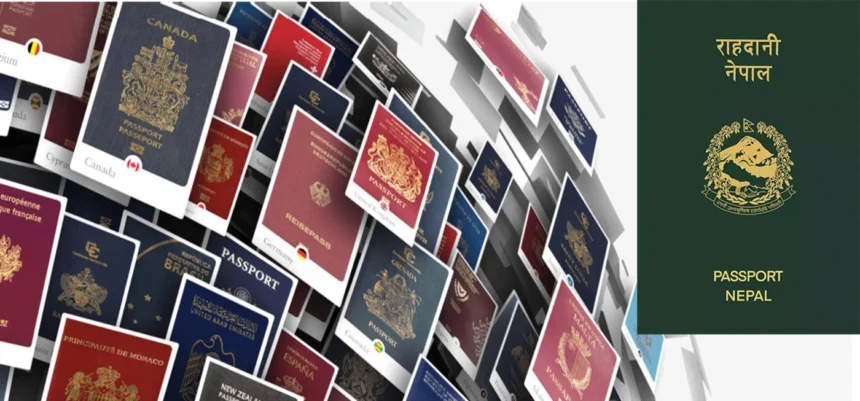According to the Henley Passport Index, the ranking of the Nepali passport seems to need to improve in the global ranking of passports. The Nepali passport is currently ranked at 100th position, allowing Nepali nationals visa-free access to only 13 countries while 40 countries can be travelled including e-visa. This ranking has remained unchanged from 2023, with Nepal sharing its position with countries as unstable as Libya and Palestine.
About Nepalese Passport
A Nepali passport (Nepali: नेपाली राहदानी) is issued by the Ministry of Foreign Affairs of Nepal to Nepali citizens for international travel purposes. Ordinary Nepali passports are chocolate brown in color with a chip symbol on their cover, commonly known as an e-passport.

Fees for making a Passport in Nepal
As of 2022, ordinary e-passports are issued at the following rates:
- NPR 5,000 for adult passports with 34 pages
- NPR 10,000 for adult passports with 66 pages
- NPR 12,000 for fast-track service with 34 pages
- NPR 20,000 for fast-track service with 66 pages
- Applicants for Nepalese passports are required to pay the authorized passport issuing office either NPR 12,000 for same-day passport issuance or NPR 15000 for passport issuance the day after the application.
Validity period
Passports are valid for 10 years from the date they are issued. You can get them from the Central Passport Office, any District Administration Office in the 77 district headquarters, or from Nepalese embassies and consulates abroad. For children under 10 years old, new regulations set the validity at 5 years.
Difference between Visa and Passport
When a citizen of one country wants to visit another country, they will first need to obtain permission, which is what a visa is. It is a stamp from a foreign country’s embassy or consulate that permits you to enter the country for a specific purpose and duration. Visas are issued by the embassy or consulate of the country you wish to visit and are only valid for the period and purpose of travel specified on the visa.
On the other hand, a passport is your country’s official ID that allows you to travel internationally. It is issued by your country of citizenship’s government. Passports are typically valid for a set number of years, usually 5 or 10, and must be renewed after their expiration.
Where Can Nepalese Passport Holders Travel Without a Visa?

As of May 2024, Nepalese passport holders can travel visa-free to 13 countries and territories:
- Cook Islands
- Dominica
- Haiti
- India
- Kenya
- Micronesia
- Niue
- Pakistan
- Philippines
- Samoa
- Seychelles
- Singapore
- Saint Vincent and
- the Grenadines
But for visa-free travels, you must still have a valid passport (usually six months after your departure date) and purchase travel health insurance as required by your destination country.
The following 42 countries issue eVisas for Nepalese passport holders:
- Albania
- Antigua and Barbuda
- Azerbaijan
- Bahamas
- Bahrain
- Benin
- Bhutan
- Botswana
- Burkina Faso
- Cameroon
- Democratic Republic of the Congo
- Ivory Coast
- Djibouti
- Equatorial Guinea
- Ethiopia
- Gabon
- Guinea
- Iran
- Kazakhstan
- Kyrgyzstan
- Lesotho
- Libya
- Malawi
- Malaysia
- Mongolia
- Montserrat
- Myanmar
- Nigeria
- Papua New Guinea
- Qatar
- São Tomé and Príncipe
- Sierra Leone
- South Sudan
- Saint Kitts and Nevis
- Suriname
- Taiwan
- Togo
- Uganda
- Uzbekistan
- Vietnam
- Zambia
- Zimbabwe
What Countries Issue Visa on Arrival to Nepalese Passport Holders?
Visa on arrival is a convenient option for travelers. It allows foreign nationals to obtain a visa upon reaching their destination country without the need for prior application. This hassle-free process is particularly beneficial for short-term visits, providing a secure and efficient means for entry into another country.
If you are a Nepalese citizen, you can get a visa on arrival for the 22 countries listed below:
- Bangladesh
- Bolivia
- Burundi
- Cambodia
- Cabo Verde
- Comoros
- Egypt
- Guinea-Bissau
- Laos
- Madagascar
- Maldives
- Mauritania
- Mauritius
- Mozambique
- Palau
- Rwanda
- Senegal
- Somalia
- Sri Lanka
- Tanzania
- Timor-Leste
- Tuvalu
Apart from these countries, you will need a valid visa to enter the following 149 countries with a Nepalese passport:
If we date back to our past, Nepali passports held more power, allowing easy travel to European countries with visas on arrival. However, the current situation requires significant investment, waiting for visas, interviews, and more. Securing visas for developed countries like those in Europe and America feels like winning a war.
But what’s the reason behind the downfall of the Nepali Passport?
In the 18 years since the political change of 2006, the global ranking of the Nepali passport has dropped by 27 places. It may be surprising to many, but the Nepali passport is now weaker than even North Korea’s, a country that has been widely condemned for its one-party communist dictatorship.
Unfortunately, the increasingly weak Nepali passport results in Nepalis not being taken seriously on the global stage. Nepal’s low international standing is worrying. This concern is heightened because Nepal is now at peace. The country is not involved in major criminal activities. It is also free from significant terrorist activities. Most importantly, Nepal is a democratic country.
Some Nepalis travel abroad with one purpose in mind but end up staying and working there secretly or illegally. This behavior has led to a decrease in trust towards Nepalis, especially in developed countries. As a consequence, these countries have become more cautious and skeptical. Due to this lack of trust, many countries have decided to stop issuing on-arrival visas to Nepalis. This change in visa policy reflects the broader concerns and challenges associated with illegal immigration and unauthorized employment. The impact of this is significant, affecting the ease with which Nepalis can travel internationally.
The misuse of diplomatic passports by some of our politicians, including members of parliament, is a major reason for the declining credibility of Nepali passports. This has led to foreigners distrusting not only the people but also the leaders of Nepal. Consequently, the Nepali passport has been slipping down the ranking index every year.
Conclusion
The low ranking of the Nepali passport is embarrassing. This weak passport is a major reason why many young Nepalis are leaving Nepal. They are seeking permanent residency in other countries. It is very concerning to see that successive governments have done nothing to address this issue. The ranking of the Nepali passport will not improve without significant efforts.
Advancing the country on the road to prosperity is essential for improvement. Without progress and development, the status of the Nepali passport is unlikely to change. This situation highlights the need for effective governance and proactive measures.









